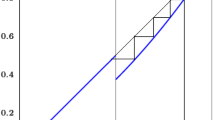Abstract.
We modify a simple mathematical model for natural selection originally formulated by Robert M. May in 1983 by permitting one homozygote to have a larger selective advantage when rare than the other, and show that the new model exhibits dynamical chaos. We determine an open region of parameter space associated with homoclinic points, and prove that there are infinite sequences of period-doubling bifurcations along selected paths through parameter space. We also discuss the possibility of chaos arising from imbalance in the homozygote fitnesses in more realistic biological situations, beyond the constraints of the model.
Similar content being viewed by others
Author information
Authors and Affiliations
Additional information
Received 3 February 1995; received in revised form 1 November 1995
Rights and permissions
About this article
Cite this article
Charter, K., Rogers, T. Homoclinic chaos in a model of natural selection. J Math Biol 35, 294–320 (1997). https://doi.org/10.1007/s002850050053
Issue Date:
DOI: https://doi.org/10.1007/s002850050053




